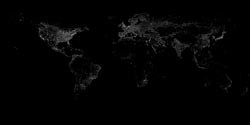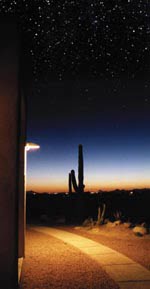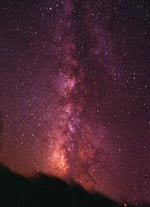Four hundred years ago, Galileo made his first astronomical observation through a telescope. Today he wouldn’t recognize the skies because light pollution prevents us from seeing the stars clearly from the most populated areas of the world. Most people in North America and Eastern Europe are familiar with an orangey glow in the sky over populated areas. In fact, according to the Tucson, Ariz.-based International Dark-Sky Association (IDA), the orangey sky glow over Los Angeles is visible from an airplane 200 miles away.

Images taken by satellite show the extent of light pollution across the globe. Photo courtesy of NASA. Data courtesy of Marc Imhoff of NASA Goddard Space Flight Center and Christopher Elvidge of NOAA National Geophysical Data Center. Image by Craig Mayhew and Robert Simmon, NASA Goddard Space Flight Center.
Besides sky glow, there are other forms of light pollution: glare, an overly bright point of light; light trespass, light shining on a location where it is not needed or wanted; and light clutter, the presence of too many bright light sources in one area.
Why it’s bad
Although light has many advantages, allowing people to work and study into the night, enjoy recreation in the evening, be safe in dark areas and more, studies show that excessive lighting has several drawbacks. First, according to David L. Crawford, co-founder of IDA, it’s a waste of energy.

Full-cutoff lighting reduces light trespass, sky glow and other light nuisances. Photo by Bob Crelin.
Light pollution also is having deleterious effects on human health. In 1987, Dr. Richard G. Stevens, a professor at the University of Connecticut School of Medicine in Farmington, proposed that electric lighting at night disrupts circadian rhythms, causing hormonal changes that could contribute to breast cancer.
Just as it creates problems for humans, excessive light also harms wildlife. Biologists warn that a kind of cascading effect can take place, with light pollution affecting animals, their habitat and so on, to result in devastation of entire ecosystems.
The US Air Force’s Defense Meteorological Satellite Program (DMSP) has taken satellite images of the Earth since the 1970s; from these, researchers have determined that about two-thirds of the world’s population and about 99 percent of the US population (excluding Alaska and Hawaii) and the European Union live in areas where the night sky is considered polluted. Seeing the heavens and the Milky Way has become a thing of the past for the majority of the world’s population.

The Milky Way is visible only in the most rural areas. Photo by Bob Crelin.
Addressing the issue
Fortunately, something is being done about light pollution. Many states and countries have lighting ordinances in place that regulate lighting levels. The IDA and the Illuminating Engineering Society of North America are developing a model lighting ordinance to help states, countries and even condominium associations protect the dark sky. Christian Monrad, president of the IDA’s board of directors, pointed out that what is at the core of any ordinance should be “warranted” use – “meaning only put the light where and when it’s needed.”
With the focus on sustainability and green building practices, building codes often have limitations on how many watts per square foot can be installed in various lighting task areas. The good news, according to Monrad, is that “energy codes continue to ratchet down to where irresponsible overlighting of outdoor projects is starting to be curtailed.”
Lights Out
One attempt by the International Dark-Sky Association (IDA) to educate the public about light pollution is the observance of National Dark-Sky Week slated April 20 to 26. This event will be preceded by the World Wildlife Fund’s Earth Hour, which is Saturday, March 28, at 8:30 p.m. local time.
Designing a fix
Shielding outdoor lighting fixtures can make a huge difference. “Without shielding it, you end up blathering light all over,” said David Crawford of the IDA. In its recommended practice guidelines, the Illuminating Engineering Society of North America (IESNA) offers optimum illumination levels for various outdoor lighting applications. By observing these well-researched standards, lighting installers can illuminate efficiently, lighting only what is necessary. In addition, specifying the use of fully shielded, or “full cutoff,” fixtures dramatically controls the trespass onto neighboring properties.
Many full-cutoff fixtures are now on the market, including the GlareBuster, which was designed specifically to reduce light pollution from residences. Patented by Connecticut-based Lighting by Branford, this fixture uses a compact fluorescent in a full-cutoff fixture. The purpose of this product, company founder Bob Crelin stated, is to replace the common floodlight that spews light in all directions. The GlareBuster is an Energy Star product that is approved by the IDA. It recently won a 2008 award in the American Lighting Association’s Lighting for Tomorrow Competition.
Defining lights path
The definition of full-cutoff lighting, as specified by the IESNA, is light distribution where the candela per 1000 lamp lumens does not exceed 25 at an angle of 90° above nadir, and does not exceed 100 at an 80° vertical angle above nadir. Light sources also play a role in light pollution. Crawford gave the astronomer’s perspective, indicating that low-pressure sodium is best because it is monochromatic, with all the light at one yellow wavelength. High-pressure sodium is next best, he said, “and any white or bluish source is the worst.” More important than light color, he emphasized, is how and when it is used.
Even with shielding, light pollution can occur from downward-directed light bouncing off whatever it is directed on, such as pavement or snow. So, besides a full-cutoff design, lights should be equipped with “occupancy” sensors so that they light up only when someone or something is in their path. Lights also can be on timers so that they turn on at dusk and off at dawn or – better yet – turn off when not needed.